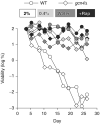Amino acid homeostasis and chronological longevity in Saccharomyces cerevisiae
- PMID: 22094422
- PMCID: PMC4603547
- DOI: 10.1007/978-94-007-2561-4_8
Amino acid homeostasis and chronological longevity in Saccharomyces cerevisiae
Abstract
Understanding how non-dividing cells remain viable over long periods of time, which may be decades in humans, is of central importance in understanding mechanisms of aging and longevity. The long-term viability of non-dividing cells, known as chronological longevity, relies on cellular processes that degrade old components and replace them with new ones. Key among these processes is amino acid homeostasis. Amino acid homeostasis requires three principal functions: amino acid uptake, de novo synthesis, and recycling. Autophagy plays a key role in recycling amino acids and other metabolic building blocks, while at the same time removing damaged cellular components such as mitochondria and other organelles. Regulation of amino acid homeostasis and autophagy is accomplished by a complex web of pathways that interact because of the functional overlap at the level of recycling. It is becoming increasingly clear that amino acid homeostasis and autophagy play important roles in chronological longevity in yeast and higher organisms. Our goal in this chapter is to focus on mechanisms and pathways that link amino acid homeostasis, autophagy, and chronological longevity in yeast, and explore their relevance to aging and longevity in higher eukaryotes.
Figures



References
-
- Amberg DC, Burke DJ, Strathern JN. Methods in yeast genetics: a Cold Spring Harbor Laboratory course manual. Cold Spring Harbor Laboratory Press; Cold Spring Harbor, NY: 2005.
-
- Andrews ZB. Uncoupling protein-2 and the potential link between metabolism and longevity. Curr Aging Sci. 2010;3:102–112. - PubMed
Publication types
MeSH terms
Substances
Grants and funding
LinkOut - more resources
Full Text Sources
Medical
Molecular Biology Databases

